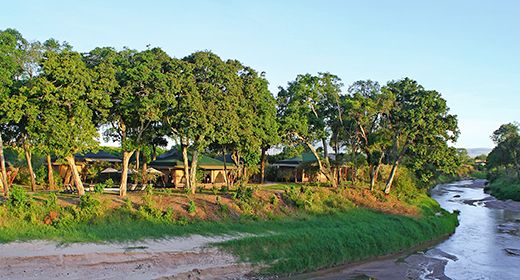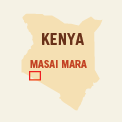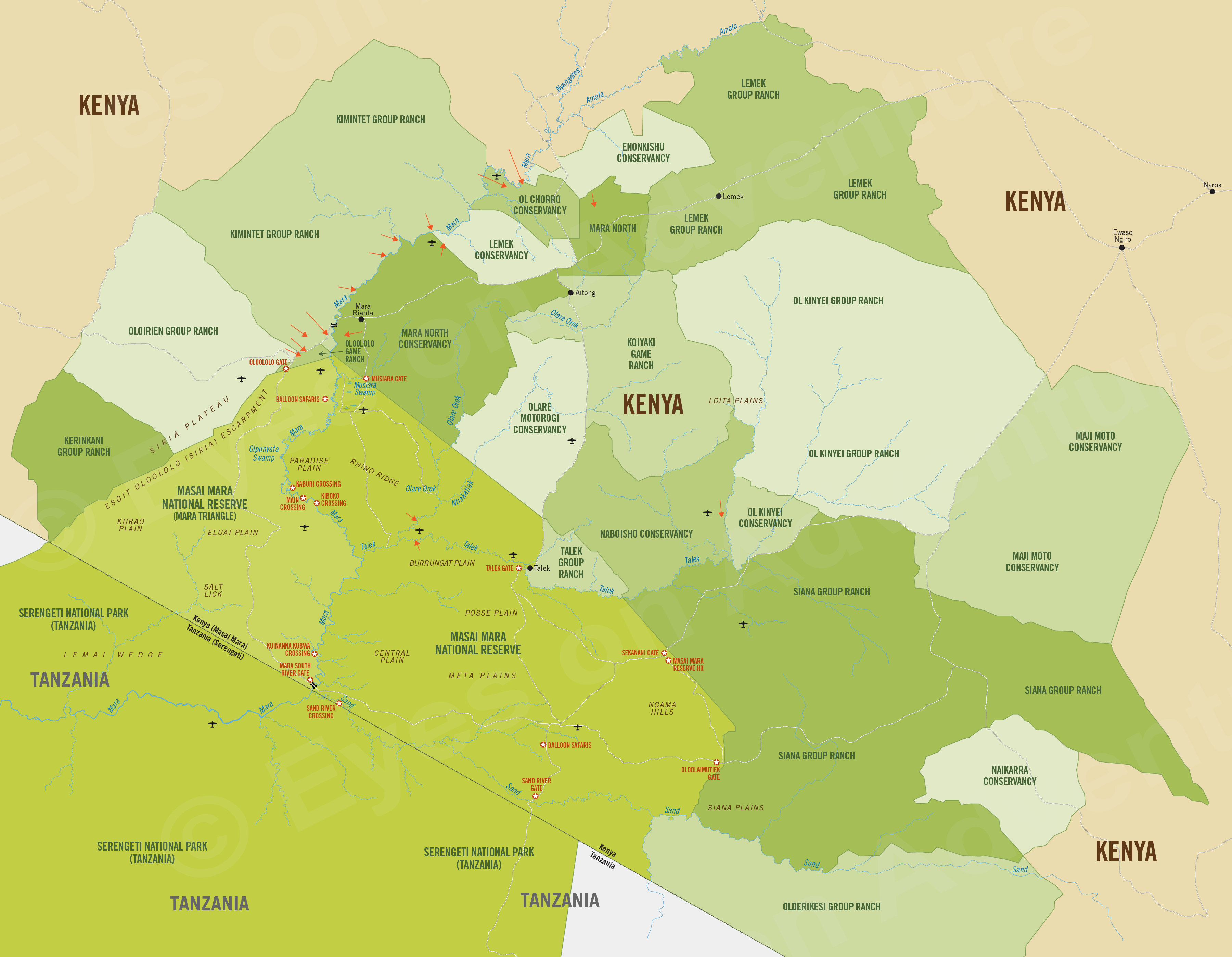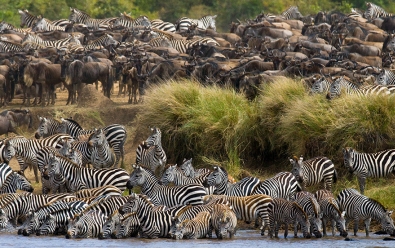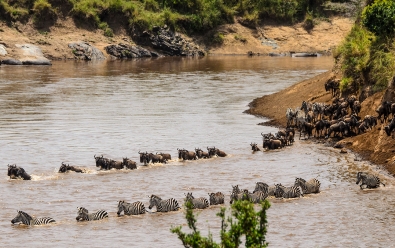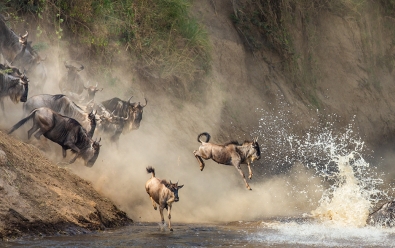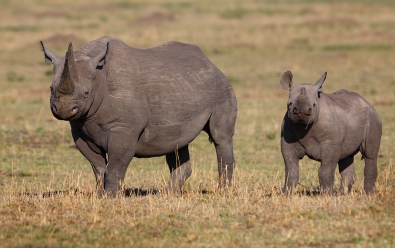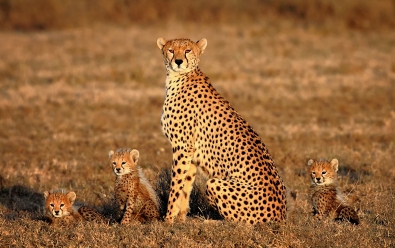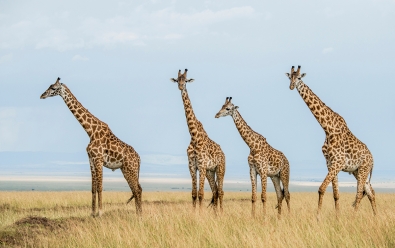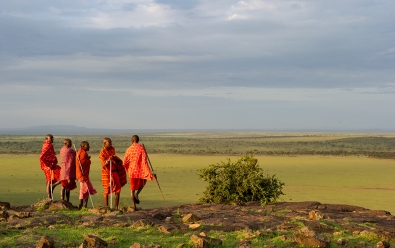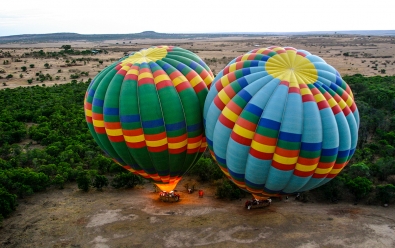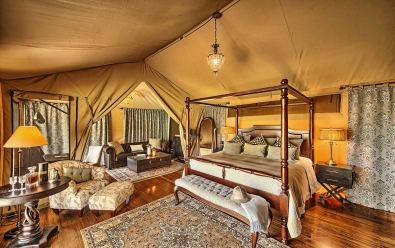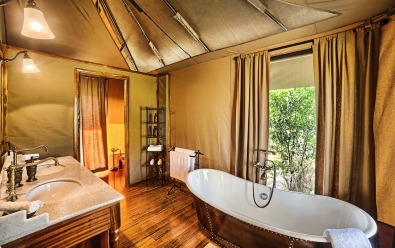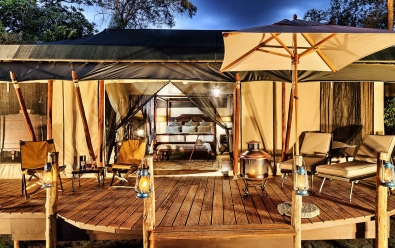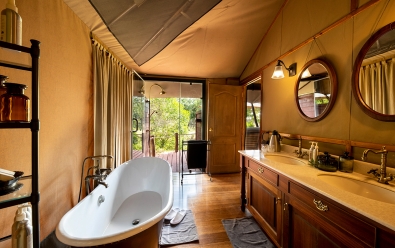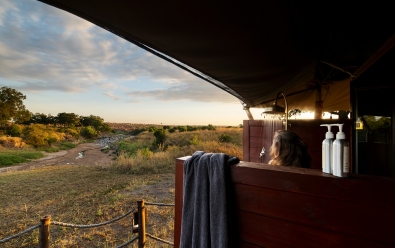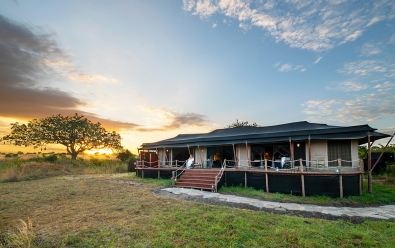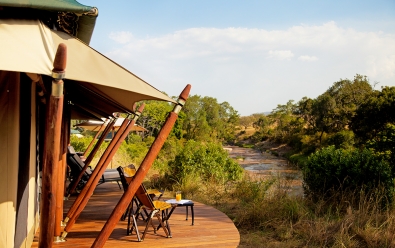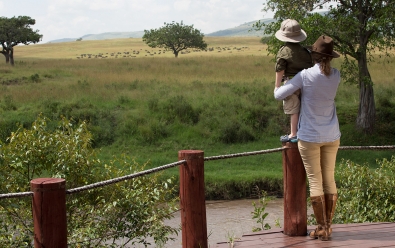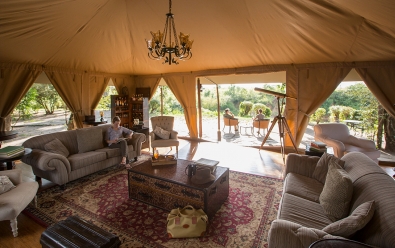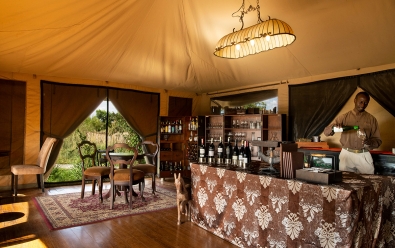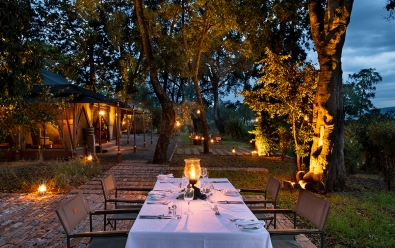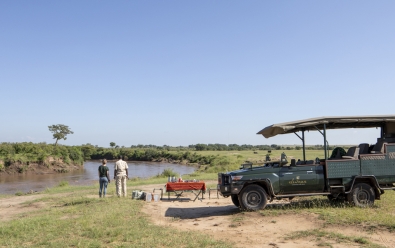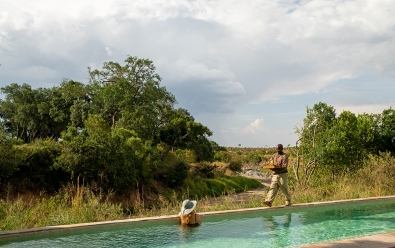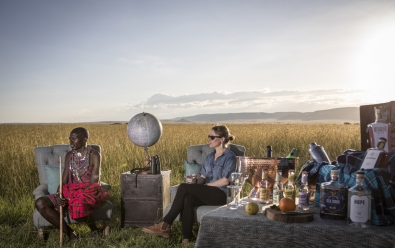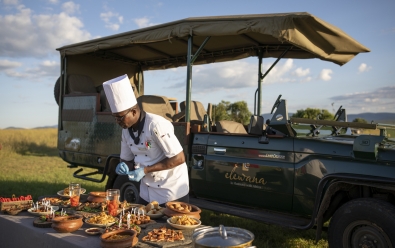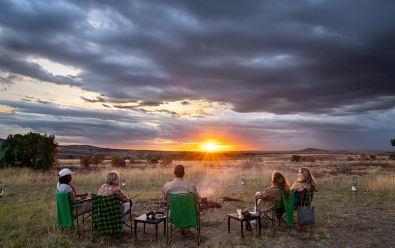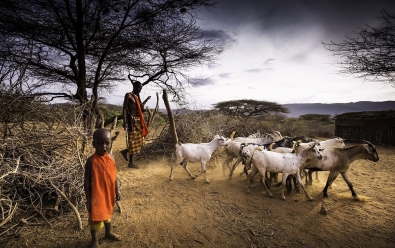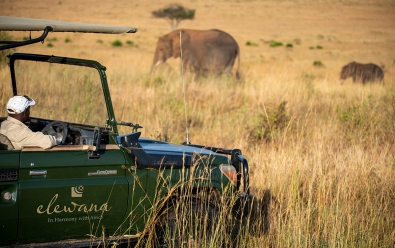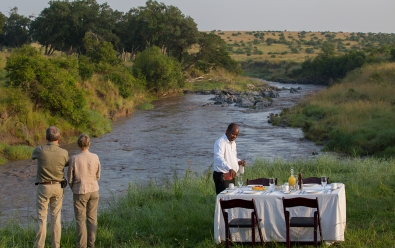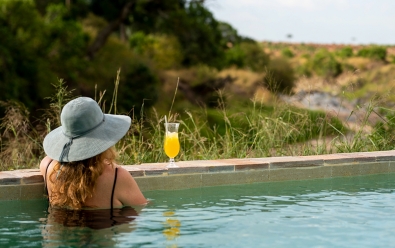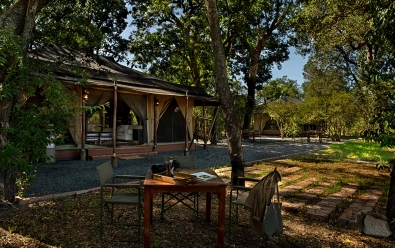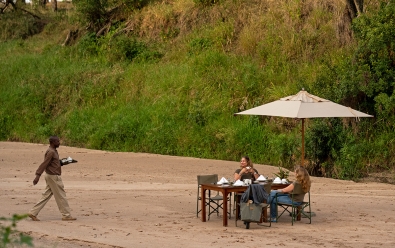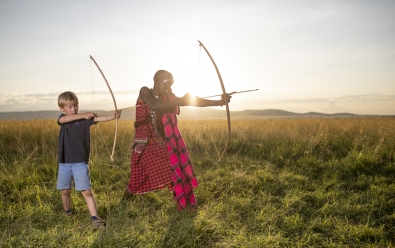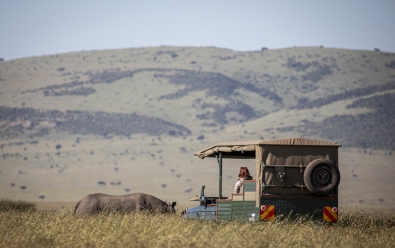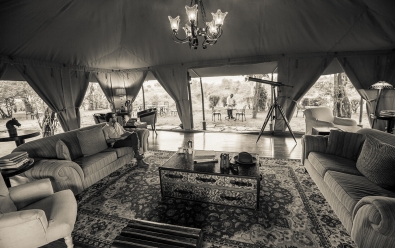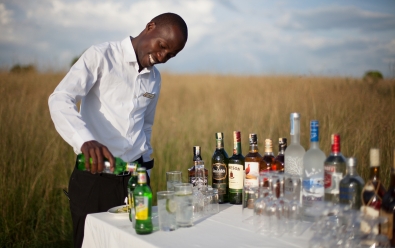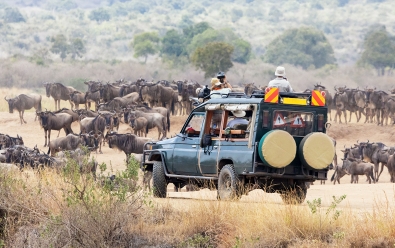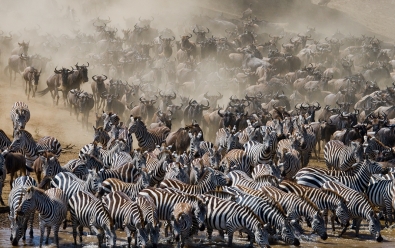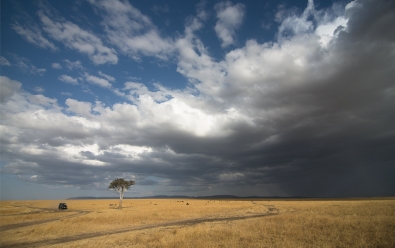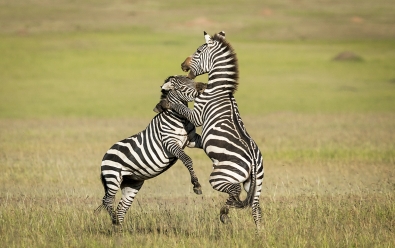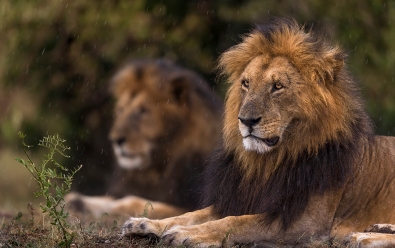Sand River Mara Camp
Highlights
- Very good wildlife viewing all year
- Secluded location away from other safari camps
- In the path of the renowned Great Migration
- Evokes the feel of a 1920s luxury safari camp
Location
- Masai Mara Reserve / Sand River
- Greater Masai Mara
- Southwest Kenya
Sand River Mara Camp is situated along a scenic and secluded section of the Sand River in the southern Masai Mara Game Reserve and on the route of the Great Migration.
The camp's location in the far southern part of the Masai Mara has only a few other safari camps, which means guests will experience an exclusive experience without the crowds often seen further west in the reserve along the Mara River.
The migration of hundreds of thousands of wildebeests and zebras passes through this area annually between August and October, after which the animals move south again back into Tanzania's Serengeti.
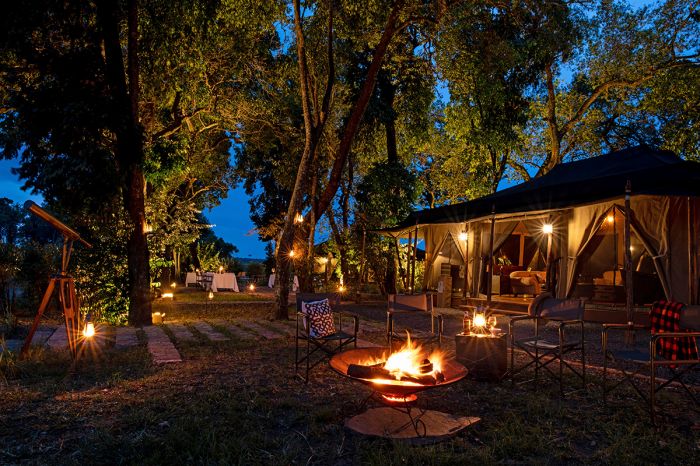
Main guest area at Sand River Mara Camp.
Activities at Sand River Mara focus on safari game drives to see the area's resident wildlife, but guests can also experience a hot-air balloon ride to get an incredible bird's-eye view above the Masai Mara. Cultural experiences include visits to a local Maasai village and school, as well as interacting with your Maasai guide.
Sand River Mara has 16 guest tents, each with views over the Sand River and vast grasslands beyond. Wildlife is frequently seen from the camp itself and during the migration months, the herds of wildebeest and zebra often pass right through the camp. One of the guest tents is a two-bedroom family unit. Children of any age are accommodated and the camp offers child-friendly activities and menus.
The guest tents are well spaced along the river, so the camp has two main guest guest areas, each with its own dining, lounge, and bar areas. The camp's swimming pool and lounger deck also offers views over the river and provides a lovely way to relax between safari activities.
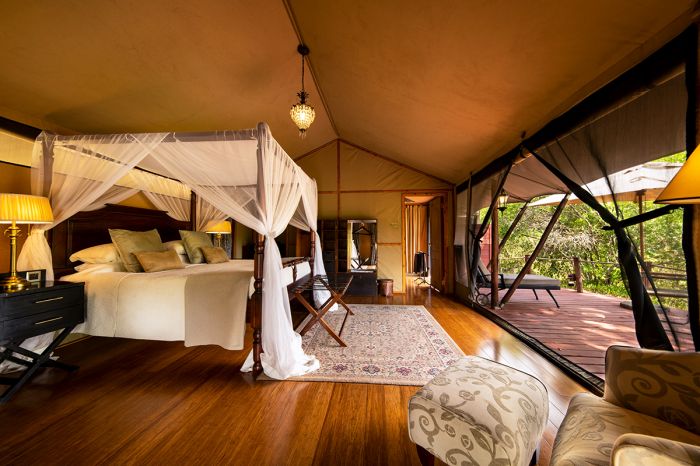
Guest tent at Sand River Mara Camp.
About the Masai Mara
The Greater Masai Mara includes the Masai Mara National Reserve as well as numerous private conservancies that border the reserve. The national reserve and bordering conservancies are often collectively referred to simply as "the Mara".
The Greater Masai Mara is part of a much larger ecosystem that includes vast protected areas directly to the south in Tanzania, including Serengeti National Park, the Ngorongoro Conservation Area, and other reserves that together make up the Greater Serengeti. The combined Greater Serengeti-Mara ecosystem, which combines the areas described above, covers roughly 15 000 square miles (39 000 sq kms).
The Serengeti-Mara is home to a very large number and diversity of wild animals and is also the location of the well-known "Great Migration" of over 2 million herbivores (read more below). This is arguably Africa's greatest overall wildlife destination.
Wildlife densities in the Greater Masai Mara are some of the highest in Africa, with commonly seen herbivores including blue wildebeest, plains zebra, Thomson's gazelle, topi, Grant's gazelle, hartebeest, giraffe, elephant, buffalo, impala, waterbuck, bush bug, warthog, and many others. Predators seen often include lion, leopard, spotted hyena, cheetah, serval, and jackal. Hippo and crocodile are found in large numbers in the Mara River.
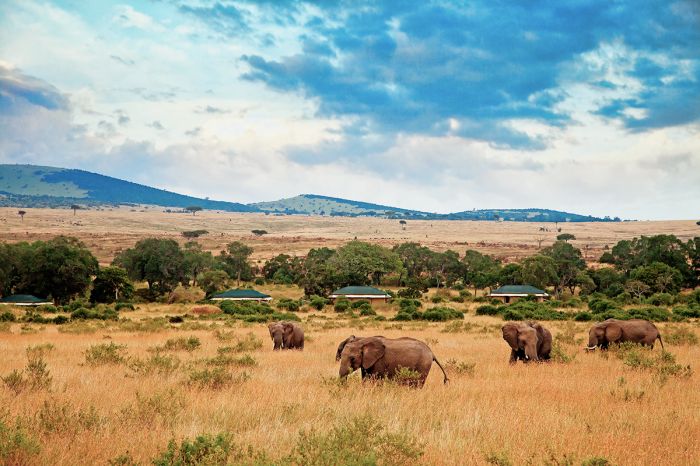
Elephants grazing with Sand River Mara Camp just behind them.
Masai Mara National Reserve
The national reserve forms the core protected area of the Greater Masai Mara, covering 583 square miles (1 510 sq kms) and officially protected since 1974. The reserve is functionally the same as a national park, with restrictions on off-road driving and open to the public, which includes self-drivers coming for the day, as well as guests staying at one of the accommodations within the reserve (of which there are many).
The Mara Triangle
The Mara River flows southward through the national reserve on its way into Tanzania and eventually into Lake Victoria to the southwest. The river also separates the national reserve into two separately-managed sections: the area to the west of the Mara River is known as the "Mara Triangle", while the area to the east of the river is simply the Mara National Reserve.
The Mara Triangle covers 197 square miles (510 sq kms), which is roughly one-third of the reserve and there are relatively few safari camps in this section, so the number of vehicles and tourists, especially during the peak months when the migration is in present, is much lower in the Triangle section than in the section east of the Mara River.
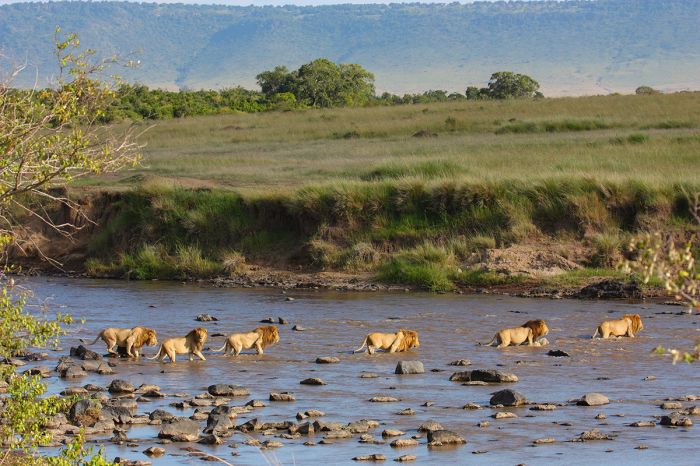
A group of male lions crossing the Mara River (a very rare sighting)!
The Great Migration
One of nature's greatest living spectacles is the Great Migration, a term given to describe the year-long, circular, clockwise march of over two million herbivores across the Masai Mara and Serengeti grasslands. The migration animals are made up entirely of two species: the blue wildebeest and the plains zebra (the majority of which are wildebeests).
The migrating herds follow their instincts to seek out fresh grazing and so the migration is ongoing, with the herds ever moving and taking a full year to complete a cycle across the Masai Mara and Serengeti. The animals move not as one herd, but as tens of thousands of animals in multiple herds of various sizes and spread out for many miles as they move.
The wildebeests and zebras take advantage of strongly seasonal conditions, spending the wet season (November through May) on the plains of Tanzania's Serengeti and the dry season in Kenya's Masai Mara. The wildebeests give birth between January and March on the short grass plains in Tanzania.
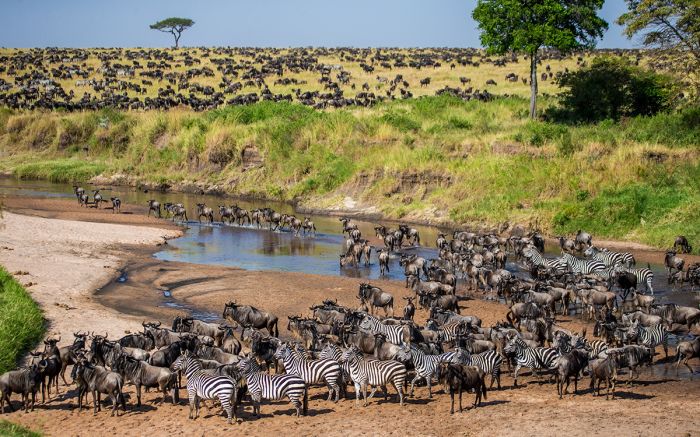
The Great Migration along the Sand River in the Masai Mara.
The timing of the migration is rarely ever the same year-to-year, as local conditions influence grass growth and as such, the location of the bulk of there animals cannot be known precisely. Rains and other unknown conditions seem to direct the timing of the migration, but generally, it is known within several weeks when the animals will be in a general location.
The migration typically crosses north into Kenya and the Masai Mara beginning sometime in mid- or late-July and they spend around three months in the Greater Masai Mara. The herds head back south into Tanzania sometime in October.
Although many visitors time their visit to the Masai Mara to coincide with the Migration, the Greater Mara has superb wildlife viewing outside of the migration period. This is because it is only the wildebeests and zebras that migrate, the rest of the animals, including the major predators like lion, leopard, spotted hyena, and cheetah, as well as all the other herbivores, including springbok, gazelles, elephant, topi, hartebeest, and many others, do not migrate.
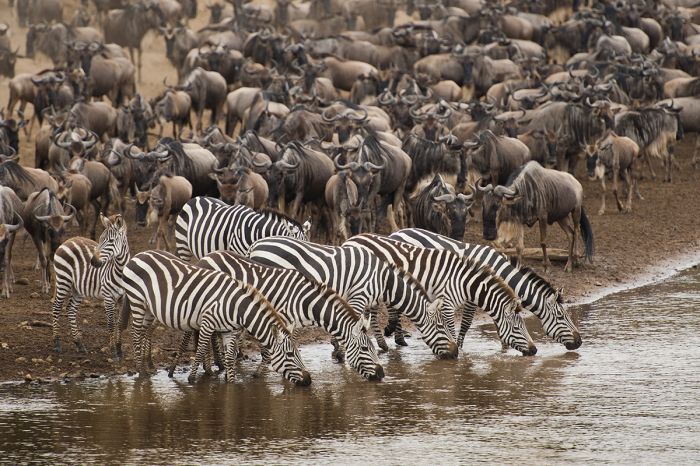
Wildebeests and zebras at the Mara River during the Great Migration.
A popular aspect of experiencing the Great Migration is observing a herd as it crosses the Mara River, which requires animals swimming through waters inhabited by large Nile crocodiles that wait for a chance to get their first substantial meal in many months.
The dramatic river crossings (which take place along the Mara River in both Kenya and Tanzania) are certainly a spectacle and not for the faint of heart, with many of the wildebeest and zebras taken by crocs or succumbing to drowning or trampling in the chaos.
The best chances for seeing a Kenya Mara River crossing are during July and August, when the crocodiles are still very hungry.
Mara Conservancies
Over the past two decades, nearly all of the land situated surrounding the Masai Mara National Reserve has been organized into protected and self-managed reserves by various tribes of the Maasai people that own the land. The result has been a great expansion of wildlife tourism and the construction of safari tourism camps and lodges.
Note that some of the conservancies use the name 'group ranch' instead of conservancy.
Many of these conservancies, particularly those that directly border the national reserve, offer wildlife viewing that is even just as good, and arguably even better than inside the reserve, primarily because the conservancies are only available to tourists staying at a camp within the conservancy and unlike the national reserve itself, are not accessible to self-drive day visitors.
The exclusivity of the conservancies means that there are fewer game drive vehicles and a far lower density of tourists. Further, the number of vehicles allowed at any specific animal sighting (such as a lion kill or a leopard in a tree) is managed to prevent the oft-seen situation where an animal, such as a cheetah, is surrounded by 20 or more cars in the national reserve.
Staying in one of the Mara Conservancies offers guests the opportunity to have an exclusive game-viewing experience (due to the reduced tourist numbers compared to inside the national reserve), while still allowing day visits into the reserve proper (entrance fee required). A day visit into the reserve might allow seeing a major wildebeest/zebra river crossing during the migration months. Guided safari walks (during the day) and game drives past sunset are another option inside the conservancies that is not permitted inside the national reserve.
ROOMS INCLUDES & EXCLUDES CHILDREN FACILITIES ACTIVITIES
Accommodation
16 guest accommodations in total comprising:
- 15 canvas safari tents, each with two twin beds (separate mattresses with shared base). Mattress converters are available that transform the twin beds into a double bed.
- 1 double / family tent consisting of two adjoined standard tents with a roll-up canvas doorway leading to a central lounge area between the two bedrooms. Each bedroom has its own en-suite facilities as described just below.
The tents are constructed of wooden supports with canvas walls and roofing atop slightly elevated wooden floors with throw rugs. Every tent includes en-suite facilities with a double-basin vanity, bath tub, outdoor shower (under awning), and separate flush toilet. The tents are accessed via footpaths on the ground leading to the main camp area.
Four of the tents have a day bed that can be used as an extra bed.
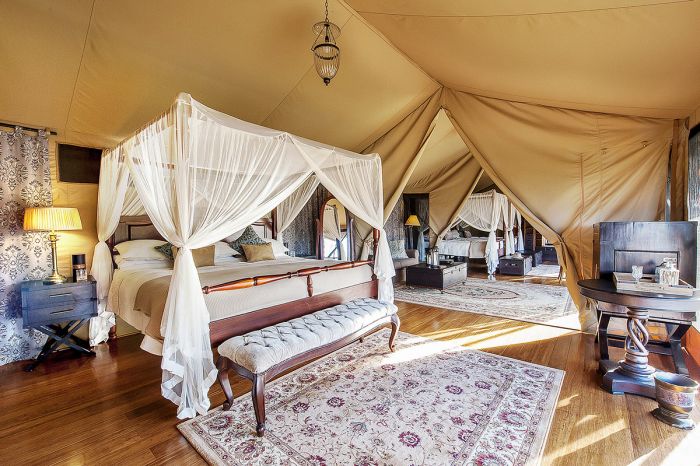
The family tent at Sand River Mara Camp.
The camp and tents are spread out along the northern bank of the Sand River, which runs northwest in this section and not far north of the Kenya-Tanzania border. Due to the long spread of tents, the camp has two separate main guest areas (lounge, dining, etc), one which services 10 tents (including the family tent) and the other servicing six tents.
Each guest tent has a wooden veranda in front with a protective canvas awning and outdoor seating, providing views over the Sand River and grasslands beyond. The interiors of the tents are elegantly furnished using 1920s-style, luxury-safari décor and bathroom fixtures, providing guests with a romantic setting for their stay.
The tents are spacious, covering 690 square feet (64 sq meters).
Other items and features in the guest tents include:
- Writing desk and chair.
- Lounge area with comfortable couch.
- Mini bar.
- Pedestal fan.
- Mosquito netting over the beds.
- 24-hour power for lighting and charging electronics.
- Bathrobes and slippers.
- Hairdryer.
- Electronic safe.
- WiFi available in the guest tents and main guest areas.
- Mobile phone signal available, but limited.
Sand River Mara Camp can accommodate a maximum of 38 guests in total: 2 persons in each of the 15 standard tents, 4 persons in the family tent, and 4 tents convertible to a triple.
Includes & Excludes
Includes:
- All meals and local beverages including soft drinks, house wines, local brand spirits and beers, teas, and coffees.
- Safari experiences (twice-daily or full-day game drives and birding) accompanied by an experienced guide.
- Laundry services are provided on a daily basis (weather permitting, items will be returned on the same day). Laundry is dried by the sun and on most days any laundry placed out in the morning will be returned by the evening.
- Wi-Fi access (throughout the entire camp).
- Keekorok Airstrip transfers.
- Tourism Levy & VAT.
Excludes:
- Champagne, cognacs, fine wines, premium brand spirits, and cigars.
- Hot-air ballooning (must be booked in advance).
- Bush breakfasts and picnic lunches (for full-day drives).
- Purchases from the Gift Shop.
- Any applicable wildlife fee, park fee, reserve fee, concession fee, other land-use fee.
Single Supplement
A single supplement may apply for any room booked by a single traveler; please ask us for pricing.
Children
Children of any age are accommodated at Sand River Mara Camp:
- 4 tents available as triples.
- Ask us about reduced rates for children sharing with adults or children 12-17 in their own tent.
- Child-friendly activities are offered.
- Children's menu available.
Some of the children's activities include:
- Guided nature walks around the camp: short walks looking at the trees, flowers, grasses, insects, birds and bird calls, mammals, tracks, and droppings.
- Swimming pool.
- Various board games and playing cards available in camp.
- Warrior training - Learning how to make a fire, throw the Maasai rungu, make and use a bow-and-arrow.
- School visit (during normal school term times).
Facilities
The camp and tents are spread out along the northern bank of the Sand River, which runs northwest in this section and not far north of the Kenya-Tanzania border.
Due to the extended spread of 16 guest tents, the camp has two separate main guest areas, each with its own kitchen, dining area, lounge and bar, library, and guest reception. One main guest area services 10 guest tents (including the family tent) and the other services the remaining six guest tents. The swimming pool is located in the larger guest area and adjacent to the family tent.
Main guest area facilities include:
- Two main guest areas with bar, lounge, and dining tents.
- Swimming pool with sun deck located in the larger main guest area.
- Campfire on a patio with seating.
- Gift Shop.
- Complimentary Wi-Fi access.
- Mineral water is provided from dispenser points in the main camp areas. Mineral water provided during meals and in guest tents. Guests are issued with a refillable bottle.
- The camp is powered by generator.
Activities
Activities included in the rate:
- Morning and afternoon/evening game drives in semi-open 4x4 vehicles.
- Bush meals and sundowners.
- Birding.
- Child-friendly activities.
- All game drive vehicles fitted with inverters for battery charging on game drives.
Optional activities at additional cost:
- Private activities are on offer (subject to vehicle availability, which needs to be booked in advance).
- Hot-air ballooning (please book in advance).
- Guided visit to a local school supported by Land & Life Foundation.
- Guided cultural visit to a Maasai village.
Example of a typical day:
- Early morning wake-up call. Morning wake-up and activity times vary according to the seasons, activities on offer, and wildlife sightings.
- Light breakfast before departing on the morning activity or food packed for an earlier departure.
- Return to the lodge for a meal and rest period (full-day outings mean lunch is packed).
- Meet for afternoon tea and snacks (savory and sweet choices) before departing on the activity.
- Return to camp - freshen up or meet for drinks, followed by dinner.
- Enjoy a nightcap and/or discussion at the bar or around the campfire before retiring.
Great Good Fair Poor
- Jan
- Feb
- Mar
- Apr
- May
- Jun
- Jul
- Aug
- Sep
- Oct
- Nov
- Dec
General Tips
The best to to visit the Masai Mara is during the dry season, between June and October, which also happens to coincide with the arrival of the Great Migration into Kenya (read more about this below).
Besides the Great Migration, the other big factor that impacts a stay in the Mara is rains. The region experiences most of its rain between November and May, but there are two somewhat distinct rain seasons, the 'short' rains and the 'long' rains.
Sand River Mara Camp is open year-round; minimum 2-night stay.
Rain Season
Short Rains
The short rains occur for about one month sometime during November and December (the exact time varied somewhat year to year). This period is called the 'short' rains because the duration of an individual rain event is short and it is rare to have an all-day rain event. Most rain falls as an afternoon shower, while mornings are typically overcast or clear.
Long Rains
The long rains occur between March and May, with April being the wettest month of the year. During this tome, rain should be expected almost every day and the showers can last for hours at a time, although all-day rain is not typical. The roads in the Masai Mara become muddy and very difficult in places, which can hamper game drives. Cloudy skies are typical and temperatures can be chilly at times.
The period between the short and long rains (January and February) also receives rain, but many days are clear and the amount and duration of the rain events is unpredictable, with some afternoon showers and the odd long and heavy rainfall event.
Temperatures
The temperatures in the Greater Masai Mara do not have great variation throughout the year, as the region lies approximately 1 degree south of the equator. In general, daytime temperatures are comfortably warm and overnights and early mornings are chilly. Bring a fleece and rain jacket regardless of the timing of your visit.
Dry Season
The dry season (June to October) is sunny and warm most days and rarely hot. Rare rain showers can occur but are unlikely. From June thru August, the afternoon temperature averages 76-78°F (24-25°C), but some days can be warmer. Evenings and early mornings temperatures are often chilly, averaging 53-55°F (12-13°C).
September and October days are very pleasant, with temperatures averaging 80-83°F (28-30°C), with cool mornings persisting, averaging 53-56°F (11-13°C).
Rainy Season
The rain season is November through May (read more above) and the temperatures are fairly static throughout the season. Daytime temperatures average 79-83°F (26-28°C) and nighttime and early morning temperatures are chilly, but slightly warmer than the dry season, averaging 54-57°F (12-14°C).
The Great Migration
The annual movement of wildebeest and zebras across the Serengeti-Mara ecosystem is one of the greatest spectacles in the natural world. Many people visiting Kenya's Masai Mara (or the Serengeti in Tanzania) will time their visit to be able to experience the Great Migration of over two million animals (all of them blue wildebeests and plains zebras).
The migration moves across both the Greater Masai Mara (in Kenya) and the Greater Serengeti (in Tanzania) in a fairly consistent pattern and timeframe. The animals move to take advantage of fresh grasses on which to graze.
The large herds are well spread out, but follow a roughly clockwise and somewhat circular track across southern Kenya and northern Tanzania, taking a full year to complete. The migrating herds are in Kenya's Greater Masai Mara from around late July until sometime in October (note that the timing is never precise and varies somewhat year to year).
The wildebeests and zebras are taking advantage of the strongly seasonal conditions, spending the wet season on the northeastern plains of Tanzania and the dry season on the plains of southwestern Kenya. The wildebeest give birth between January and March on the short grass plains of the southern Serengeti in Tanzania.
The migration is rarely ever the same in terms of precise timing and direction, as local conditions influence grass growth. The wildebeest may, therefore, move off the open plains earlier in some years and remain in the northern woodlands for longer in others.




